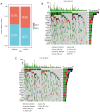Prognostic value and immune landscapes of disulfidptosis‑related lncRNAs in bladder cancer
- PMID: 39776943
- PMCID: PMC11706340
- DOI: 10.3892/mco.2024.2814
Prognostic value and immune landscapes of disulfidptosis‑related lncRNAs in bladder cancer
Abstract
Disulfidptosis, which was recently identified, has shown promise as a potential cancer treatment. Nonetheless, the precise role of long non-coding RNAs (lncRNAs) in this phenomenon is currently unclear. To elucidate their significance in bladder cancer (BLCA), a signature of disulfidptosis-related lncRNAs (DRlncRNAs) was developed and their potential prognostic significance was explored. BLCA sample data were sourced from The Cancer Genome Atlas. A predictive signature comprising DRlncRNAs was formulated and subsequently validated. The combination of this signature with clinical characteristics facilitated the development of a nomogram with practical clinical utility. Additionally, enrichment analysis was conducted, the tumor microenvironment (TME) was assessed, the tumor mutational burden (TMB) was analyzed, and drug sensitivity was explored. Reverse transcription-quantitative PCR (RT-qPCR) was utilized to quantify lncRNA expression. The results revealed an eight-gene signature based on DRlncRNAs was established, and the predictive accuracy of the nomogram that incorporated the risk score [area under the curve (AUC)=0.733] outperformed the nomogram without it (AUC=0.703). High-risk groups were associated with pathways such as WNT signaling, focal adhesion and cell cycle pathways. The TME study revealed that high-risk patients had increased immune infiltration, whereas the TMB and tumor immune dysfunction and exclusion scores in low-risk patients indicated a potentially robust immune response. Drug sensitivity analysis identified appropriate antitumor drugs for each group. RT-qPCR experiments validated significant differences in DRlncRNAs expression between normal and BLCA cell lines. In conclusion, the prognostic risk signature, which includes the eight identified DRlncRNAs, demonstrates promise for predicting prognosis of patients with BLCA and guiding the selection of suitable immunotherapy and chemotherapy strategies.
Keywords: BLCA; disulfidptosis; lncRNAs; prognostic signature.
Copyright: © 2025 Liu et al.
Conflict of interest statement
The authors declare that they have no competing interests.
Figures








Similar articles
-
Preliminary findings on the development of a predictive model for BLCA based on disulfidptosis-associated IncRNAs signature.BMC Urol. 2024 Mar 26;24(1):69. doi: 10.1186/s12894-024-01454-3. BMC Urol. 2024. PMID: 38532369 Free PMC article.
-
Integrated single-cell analysis reveals the regulatory network of disulfidptosis-related lncRNAs in bladder cancer: constructing a prognostic model and predicting treatment response.Front Oncol. 2025 Mar 5;15:1527036. doi: 10.3389/fonc.2025.1527036. eCollection 2025. Front Oncol. 2025. PMID: 40110199 Free PMC article.
-
Exploration on the construction of a bladder cancer prognostic model based on disulfidptosis-related lncRNAs and its clinical significance.Sci Rep. 2024 Nov 5;14(1):26751. doi: 10.1038/s41598-024-78481-5. Sci Rep. 2024. PMID: 39500988 Free PMC article.
-
Construction and validation of a prognostic model for bladder cancer based on disulfidptosis-related lncRNAs.Medicine (Baltimore). 2024 Jul 5;103(27):e38750. doi: 10.1097/MD.0000000000038750. Medicine (Baltimore). 2024. PMID: 38968515 Free PMC article.
-
Identification of a novel defined inflammation-related long noncoding RNA signature contributes to predicting prognosis and distinction between the cold and hot tumors in bladder cancer.Front Oncol. 2023 Mar 29;13:972558. doi: 10.3389/fonc.2023.972558. eCollection 2023. Front Oncol. 2023. PMID: 37064115 Free PMC article.
References
-
- Witjes JA, Bruins HM, Cathomas R, Compérat EM, Cowan NC, Gakis G, Hernández V, Linares Espinós E, Lorch A, Neuzillet Y, et al. European association of urology guidelines on muscle-invasive and metastatic bladder cancer: Summary of the 2020 guidelines. Eur Urol. 2021;79:82–104. doi: 10.1016/j.eururo.2020.03.055. - DOI - PubMed
LinkOut - more resources
Full Text Sources
